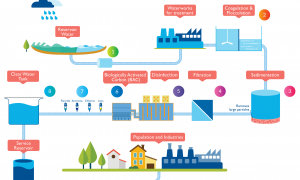🕑 Reading time: 1 minute
Lacey investigated the stability conditions of different alluvial channels and came up with Lacey’s silt theory which explains about the different regime conditions of a channel such as true regime, initial regime, and final regime and the design procedure of canal.
Contents:
Lacey’s Silt Theory of Canals
Lacey stated that a channel may not be in regime condition even if it is flowing with non-scouring and non-silting velocity. Therefore, he distinguished three regime conditions as follows :
- True regime
- Initial Regime
- Final Regime
1. True regime
A channel is said to be in regime condition if it is transporting water and sediment in equilibrium such that there is neither silting nor scouring of the channel. But according to Lacey, the channel should satisfy the following conditions to be in regime condition.
- Canal discharge should be constant.
- The channel should flow through incoherent alluvium soil, which can be scoured as easily as it can be deposited and this sediment should be of the
same grade as is transported. - Silt grade should be constant.
- Silt charge, which is the minimum transported load should be constant.
If the

2. Initial Regime
A channel is said to be in initial regime condition when only the bed slope of channel gets affected by silting and scouring and other parameters are independent even in non-silting and non-scouring velocity condition. It may be due to the absence of incoherent alluvium. According to Lacey’s, regime theory is not applicable to initial regime condition.
3. Final Regime
If the channel parameters such as sides, bed slope, depth etc. are changing according to the flow rate and silt grade then it is said to be in final regime condition. The channel shape may vary according to silt grade as shown in the figure below :

Lacey’s specified that the regime theory is valid for final regime condition only and he also specified that semi-ellipse is the ideal shape of regime channels.
Canal design using Lacey’s Silt Theory
According to lacey’s, the design procedure to build canal is as follows :
- Canal discharge (Q) and mean particle size (dm) should be known.
- From the mean size or diameter of the particle (dm), silt factor is first calculated using the below expression :

- Silt factor values for different types of soils are tabulated here.
| S.No | Soil Type | Silt Factor, f |
| 1 | Fine silt | 0.5 - 0.7 |
| 2 | Medium silt | 0.85 |
| 3 | Standard silt | 1 |
| 4 | Medium sand | 1.25 |
| 5 | Coarse sand | 1.5 |
- Using discharge and silt factor, velocity (V) can be calculated by the expression as follows :

After attaining the velocity of canal flow, find the area of the canal by dividing discharge with velocity. Also, find the mean hydraulic depth (R) of the canal and wetted perimeter (P) of the canal.

- Assume the bed slope (S) value or find by substituting the values of silt factor and canal discharge in the following formula :

Drawbacks of Lacey’s Silt Theory
- Lacey did not explain the properties that govern the alluvial channel.
- In general, flow is different at bed and sides of the channel which requires two different silt factors but Lacey derived only one silt factor.
- The semi-elliptical shape proposed by Lacey as the ideal shape of the channel is not convincing.
- Lacey did not consider the
silt concentration in his equations. - Attrition of silt particles is ignored by Lacey.
- Lacey did not give proper definitions for the silt grade and silt charge.

Also Read: Kennedy’s Silt Theory of Canals, Its Concept, Limitations, and Design


